
Lichenology is the branch of mycology that studies the lichens, symbiotic organisms made up of an intimate symbiotic association of a microscopic alga with a filamentous fungus. Lichens are chiefly characterized by this symbiosis.

The Mycocaliciaceae are a family of seven genera and about 90 species of fungi in the order Mycocaliciales.

Calicium is a genus of leprose lichens. It is in the family Caliciaceae, and has 40 species.
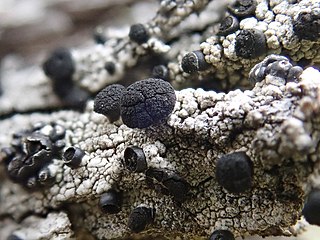
Acolium is a genus of lichenized fungi in the family Caliciaceae. The genus has a widespread distribution and contains six species. These lichens are found on bark and wood, occasionally on rocks, or growing on other lichens.

Vulpicida is a genus of lichenized fungi in the family Parmeliaceae. Circumscribed in 1993 to contain species formerly placed in Cetraria, the genus is widespread in Arctic to northern temperate regions, and contains six species. The genus is characterized by the presence of the secondary metabolites pulvinic acid and vulpinic acid, compounds that when combined with usnic acid, give the species their characteristic yellow and green colors.
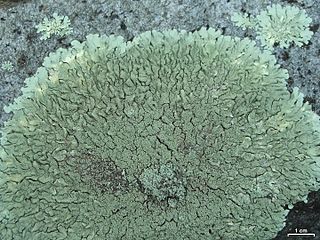
Xanthoparmelia is a genus of foliose lichens in the family Parmeliaceae. This genus of lichen is commonly found in the United States, as well as Australia, New Zealand and Ecuador.

The Caliciaceae are a family of mostly lichen-forming fungi belonging to the class Lecanoromycetes in the division Ascomycota. Although the family has had its classification changed several times throughout its taxonomic history, the use of modern molecular phylogenetic methods have helped to establish its current placement in the order Caliciales. Caliciaceae contains 39 genera and about 670 species. The largest genus is Buellia, with around 300 species; there are more than a dozen genera that contain only a single species.
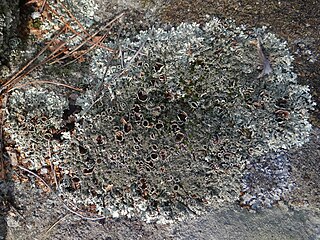
Xanthoparmelia conspersa, commonly known as the peppered rock-shield, is a foliose lichen and the type species of genus Xanthoparmelia. It is widely distributed in temperate zones, and has been recorded from Japan, Europe, Africa, North America, and South America.
Chaenothecopsis vainioana is a species of lichenicolous fungus in the family Caliciaceae that is found in Europe. It was first formally described by Czech lichenologist Josef Nádvorník in 1940 as a member of the genus Calicium. The specific epithet honours Finnish lichenologist Edvard August Vainio. Leif Tibell transferred it to genus Chaenothecopsis in 1979. Calicium vainioanum has been reported growing on Arthonia, Lecanactis abietina, and Calicium salicinum.

Calicium viride, commonly known as the green stubble lichen, is a species of pin lichen in the family Caliciaceae, and the type species of the genus Calicium. It is a common and widely distributed species in temperate areas of the Northern Hemisphere and southern South America. The thallus of the lichen consists of a basal crust, and apothecia on a stalk. Diagnostic characteristics of Calicium viride are its brown excipulum, and its green, granular crust.

Allocalicium is a single-species fungal genus in the family Caliciaceae. It is monotypic, containing the single pin lichen species Allocalicium adaequatum. This lichen occurs in North America, South America, Europe, and the Russian Far East, where it grows on branches and twigs of deciduous trees and shrubs, typically those of alder and poplar. The species was originally described in 1869 as a member of Calicium, but molecular phylogenetics analysis demonstrated it was not a member of that genus and so Allocalicium was created to contain it.
Usnea glabrata is a species of beard lichen in the family Parmeliaceae. It was first described as a variety of Usnea plicata by Erik Acharius. Finnish lichenologist Edvard August Vainio transferred it to the genus Usnea in 1915. The lichen grows on bark and is widespread throughout Europe, although it is probably locally extinct in a few locations. It is characterized by small shrubby thallus, constriction of secondary branches at their base, presence of large soralia, and the absence of both papillae and isidia.

Calicium trabinellum, commonly known as the yellow-collar stubble lichen, is a widespread species of pin lichen in the family Caliciaceae. It was first described by Swedish lichenologist Erik Acharius in 1803 as Calicium xylonellum ß trabinellum. He made the new combination Calicium trabinellum in a later chapter of the same publication.
Calicium episcalare is a rare species of pin lichen that is known from only a single locality in Sweden. It is in the family Caliciaceae. It one of the few Calicium species that is parasitic on another lichen. The type was found growing on the north-facing wall of an old wooden barn in Dalsland. The barn, which dates to the 17th century, was made from old pine wood and had likely never been painted. The specific epithet episcalare refers to the name of the host, Hypocenomyce scalaris, a common and widespread lichen. Calicium episcalare was described as a new species in 2016 by Swedish lichenologists Leif Tibell and Tommy Knutsson.

Gowardia nigricans, commonly known as the gray hair lichen or gray witch's hair, is a species of fruticose lichen in the family Parmeliaceae.
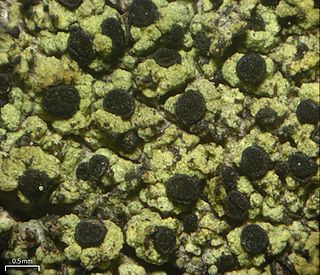
Calicium pinicola is a species of lignicolous (wood-dwelling), crustose lichen in the family Caliciaceae. It is widely distributed in Europe, and also occurs in the United States.

Solorina crocea, commonly known as the orange chocolate chip lichen, is a species of terricolous (ground-dwelling) and foliose (leafy) lichen in the family Peltigeraceae. The lichen, which was first formally described by Carl Linnaeus in 1753, has an arctic–alpine and circumpolar distribution and occurs in Asia, Europe, North America, and New Zealand. It generally grows on the bare ground in sandy soils, often in moist soil near snow patches or seepage areas. Although several forms and varieties of the lichen have been proposed in its history, these are not considered to have any independent taxonomic significance.
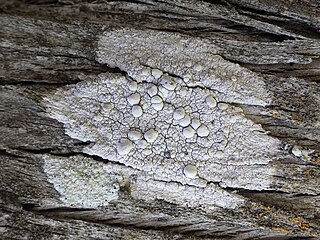
Dirina ceratoniae is a species of crustose lichen in the family Roccellaceae. It is found in Europe, where it grows on both bark and on calcium-rich rock. The lichen was formally described as a new species in 1810 by Swedish lichenologist Erik Acharius. Elias Magnus Fries transferred the taxon to genus Dirina in 1831.

Chrysothrix chlorina, the sulphur dust lichen, is a species of leprose (powdery) crustose lichen in the family Chrysotrichaceae. Originally described scientifically by the Swedish lichenologist Erik Acharius over 200 years ago, it has been shuffled to many different genera in its taxonomic history before finally being transferred to Chrysothrix in 1981. The lichen has a circumboreal distribution, meaning it occurs in northern boreal regions across the planet. It is typically saxicolous (rock-dwelling), particularly on the underside of rock overhangs, but has in rare instances been recorded growing on bark and various other surfaces.

Pseudothelomma ocellatum is a species of lignicolous (wood-dwelling), crustose lichen in the family Caliciaceae. This lichen is characterised by its grey, areolate thallus that produces abundant lichenised diaspores, such as short spherical isidia and coarse, dark brown-black soredia. It is typically sterile, meaning apothecia are absent.















